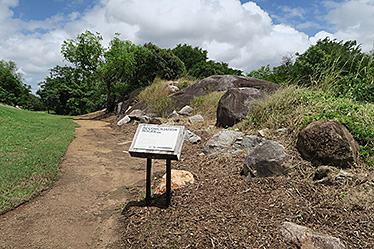Reconciliation Rocks, the site of Australia’s first act of reconciliation, now heritage listed


The site of Australia’s first recorded act of reconciliation between First Nation peoples and Europeans – on July 19, 1770 – has been entered into the Queensland Heritage Register.
Known as Reconciliation Rocks, the site is a group of granite boulders, on the banks of the Endeavour River north of Cooktown’s town centre.
“Reconciliation Rocks is enormously important in demonstrating the evolution of both Queensland’s and Australia’s history, and interactions between the country’s first inhabitants and Europeans,” Queensland Heritage Council Chair Debbie Best said.
“Here, Australia’s first recorded act of reconciliation took place after conflict over turtles, following several days of contact and cultural exchange at Gungardie or Gangaar, now known as Cooktown.
“The event is unique in Queensland’s and Australia’s history.”
On 11 June 1770, Captain James Cook’s Endeavour struck a reef off Cape Tribulation, south of Cooktown, was badly damaged, and was moored for repairs on the banks of what was later named the Endeavour River (Waalumbaal Birri).
This was sacred, neutral ground for the Wyamburr clan of the Guugu Yimithirr tribe.
While the ship was repaired in two weeks, unfavourable tides stranded Endeavour until August 1770.
Cook and his crew used the time to explore the area, restock the ship’s stores, and attempt to “cultivate a friendship and alliance” with First Nation people they met.
However, it wasn’t until three weeks after the Endeavour had arrived that the Guugu Yimithirr Bama (Bama being the collective noun for “people”) made contact.
“The Guugu Yimithirr Bama, after observing the Europeans carefully, made contact with the visitors and the two cultures exchanged food, goods and language.”
However, on 18 July 1770, a group of Guugu Yimithirr that were onboard the Endeavour noticed many turtles on the deck.
For the Endeavour crew, turtles were a valuable source of nutrition for the voyage back to England, but the turtles had been taken from sacred breeding grounds, in large numbers, and without permission from the Guugu Yimithirr Bama.
This disagreement led to the Guugu Yimithirr Bama setting fire to the grass around the crew’s campsite and Cook firing a musket, hitting one of the Guugu Yimithirr Bama, a further violation on this neutral ground.
According to historians, elders of the local clans discussed these events and a strategy was agreed upon. A number of men would visit Cook and his crew the next day and efforts would be made to make peace with them.
“Meeting at rocks near the riverbank, peace was instigated and offered by Guugu Yimithirr elder Ngamu Yarrbarigu by symbolically holding out a broken spear, accepted by Cook and his crew, and formalised by rituals including the smearing of sweat as a gesture of welcome and friendship.”
“Although language was a barrier and conflict had occurred, the actions of the local people – including carrying spears without barbs or with broken tips – communicated reconciliation more than discord,” Ms Best said.
Reconciliation Rocks has developed a strong and special association with the Cooktown community over the years.
“Many Aboriginal members of the community are descendants of the Guugu Yimithirr Bama who encountered Cook and the Endeavour crew in 1770,” Ms Best said.
“Commemorations and re-enactments of the Endeavour’s time at Cooktown have been held annually since 1959 by the Cooktown Re-enactment Association, now with an increased emphasis on Reconciliation Rocks and the perspective of the Guugu Yimithirr Bama.”
The 250th anniversary of the reconciliation was recognised in 2020 through art, movies, exhibitions, and onsite events.
The Cooktown and Cape York Expo 2021, being held 11-20 June, will also celebrate the shared story of Reconciliation Rocks.”
An application to heritage list Reconciliation Rocks was made by the Hopevale Congress Aboriginal Corporation together with the National Trust of Australia (Queensland).
It was received by the then Department of Environment and Science on 15 September 2020, with the Queensland Heritage Council entering the place into the Queensland Heritage Register at its meeting on 28 May 2021, appropriately within Australia’s National Reconciliation Week.
See more information on Reconciliation Rocks.


